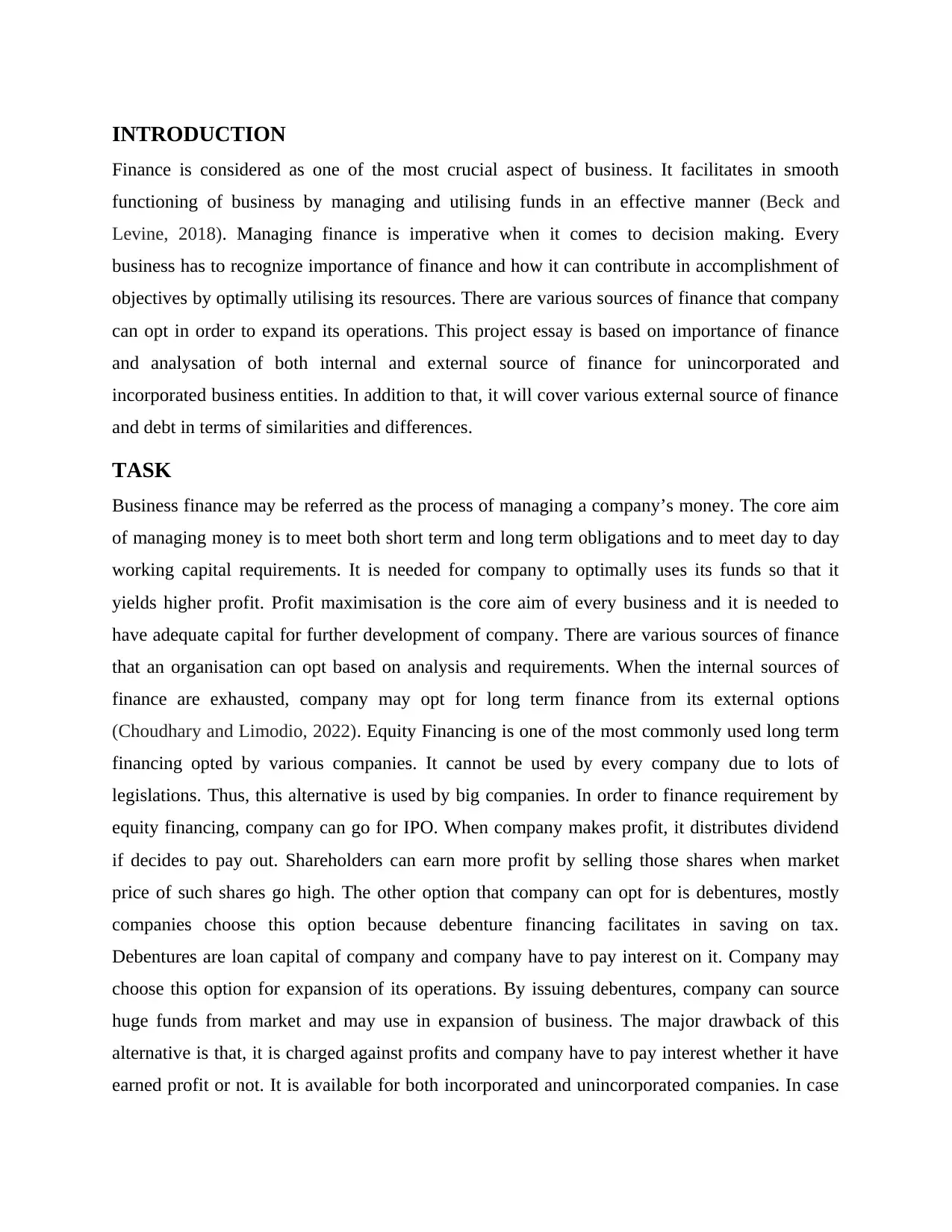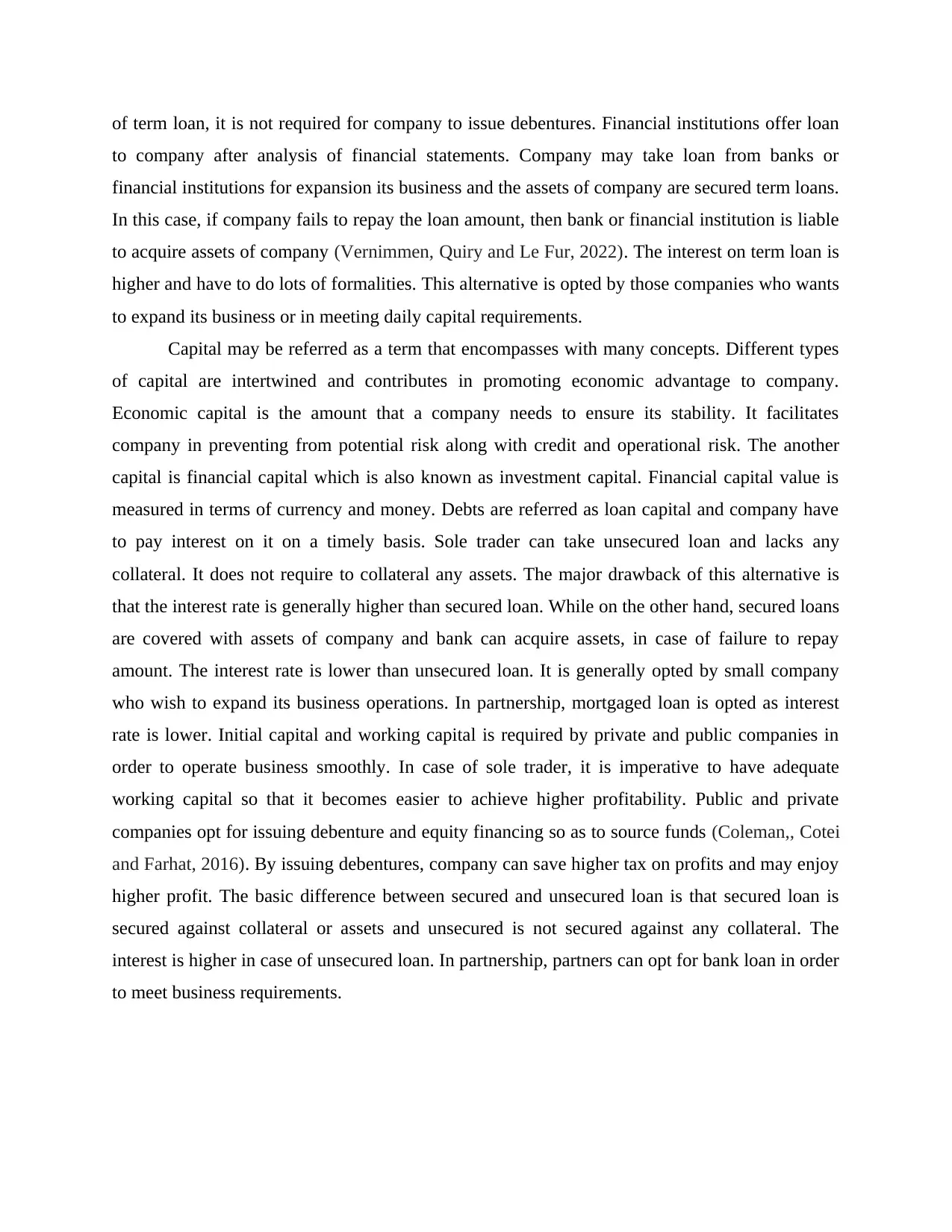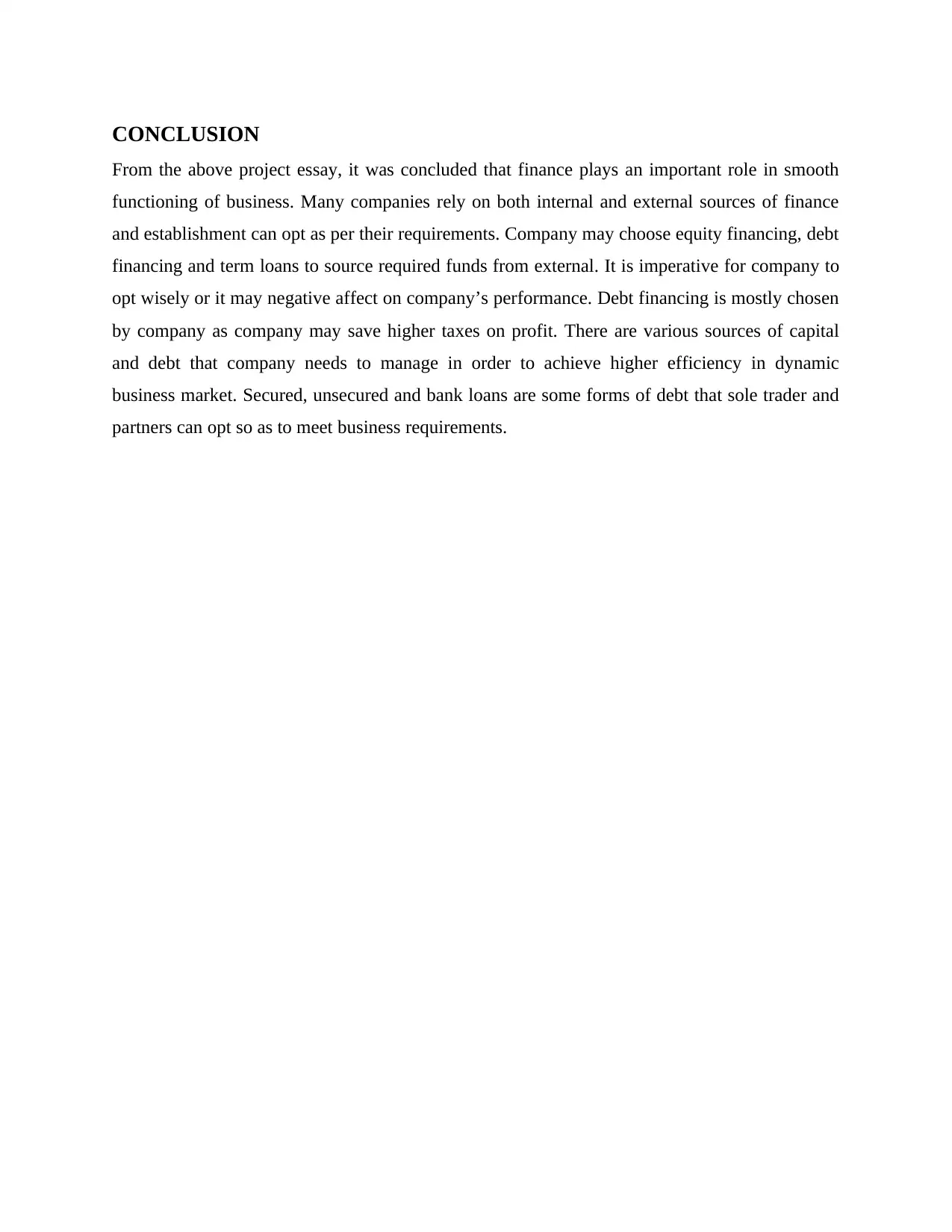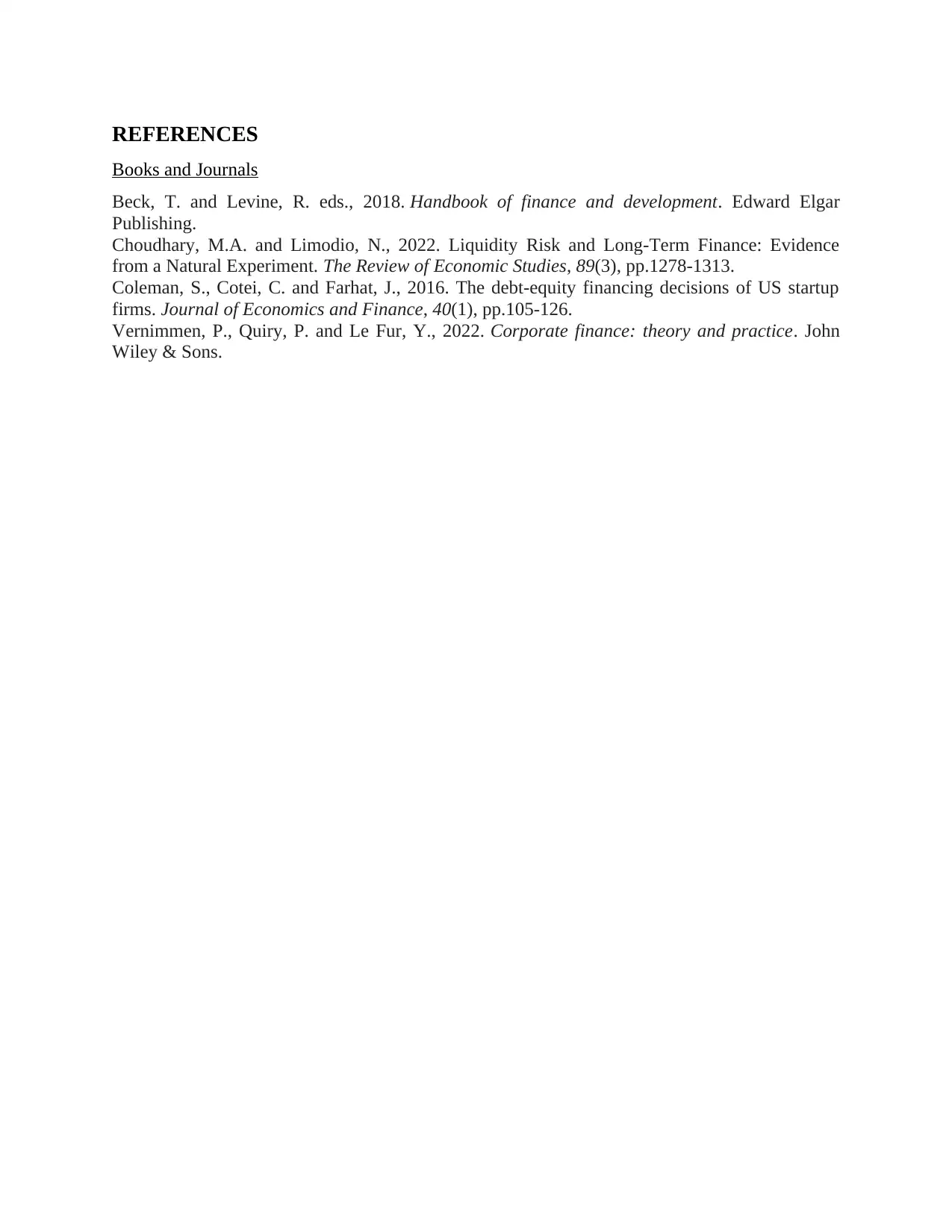Finance: Analyzing Internal & External Sources for Business Growth
VerifiedAdded on 2023/06/08
|6
|1211
|355
Essay
AI Summary
This essay examines the critical role of finance in business operations, focusing on the analysis of both internal and external sources of funding for unincorporated and incorporated entities. It highlights the importance of optimal resource utilization and strategic financial decision-making for achieving business objectives. The essay discusses various external financing options, including equity financing, debentures, and term loans, detailing their advantages and disadvantages. It further differentiates between secured and unsecured loans, emphasizing the implications for sole traders and partnerships. The conclusion underscores the significance of wise financial choices for maintaining efficiency and achieving higher profitability in the dynamic business market, noting the potential tax benefits of debt financing and the importance of managing capital and debt effectively.

Essay
Paraphrase This Document
Need a fresh take? Get an instant paraphrase of this document with our AI Paraphraser

Contents
INTRODUCTION...........................................................................................................................3
TASK...............................................................................................................................................3
CONCLUSION................................................................................................................................4
REFERENCES................................................................................................................................6
INTRODUCTION...........................................................................................................................3
TASK...............................................................................................................................................3
CONCLUSION................................................................................................................................4
REFERENCES................................................................................................................................6

INTRODUCTION
Finance is considered as one of the most crucial aspect of business. It facilitates in smooth
functioning of business by managing and utilising funds in an effective manner (Beck and
Levine, 2018). Managing finance is imperative when it comes to decision making. Every
business has to recognize importance of finance and how it can contribute in accomplishment of
objectives by optimally utilising its resources. There are various sources of finance that company
can opt in order to expand its operations. This project essay is based on importance of finance
and analysation of both internal and external source of finance for unincorporated and
incorporated business entities. In addition to that, it will cover various external source of finance
and debt in terms of similarities and differences.
TASK
Business finance may be referred as the process of managing a company’s money. The core aim
of managing money is to meet both short term and long term obligations and to meet day to day
working capital requirements. It is needed for company to optimally uses its funds so that it
yields higher profit. Profit maximisation is the core aim of every business and it is needed to
have adequate capital for further development of company. There are various sources of finance
that an organisation can opt based on analysis and requirements. When the internal sources of
finance are exhausted, company may opt for long term finance from its external options
(Choudhary and Limodio, 2022). Equity Financing is one of the most commonly used long term
financing opted by various companies. It cannot be used by every company due to lots of
legislations. Thus, this alternative is used by big companies. In order to finance requirement by
equity financing, company can go for IPO. When company makes profit, it distributes dividend
if decides to pay out. Shareholders can earn more profit by selling those shares when market
price of such shares go high. The other option that company can opt for is debentures, mostly
companies choose this option because debenture financing facilitates in saving on tax.
Debentures are loan capital of company and company have to pay interest on it. Company may
choose this option for expansion of its operations. By issuing debentures, company can source
huge funds from market and may use in expansion of business. The major drawback of this
alternative is that, it is charged against profits and company have to pay interest whether it have
earned profit or not. It is available for both incorporated and unincorporated companies. In case
Finance is considered as one of the most crucial aspect of business. It facilitates in smooth
functioning of business by managing and utilising funds in an effective manner (Beck and
Levine, 2018). Managing finance is imperative when it comes to decision making. Every
business has to recognize importance of finance and how it can contribute in accomplishment of
objectives by optimally utilising its resources. There are various sources of finance that company
can opt in order to expand its operations. This project essay is based on importance of finance
and analysation of both internal and external source of finance for unincorporated and
incorporated business entities. In addition to that, it will cover various external source of finance
and debt in terms of similarities and differences.
TASK
Business finance may be referred as the process of managing a company’s money. The core aim
of managing money is to meet both short term and long term obligations and to meet day to day
working capital requirements. It is needed for company to optimally uses its funds so that it
yields higher profit. Profit maximisation is the core aim of every business and it is needed to
have adequate capital for further development of company. There are various sources of finance
that an organisation can opt based on analysis and requirements. When the internal sources of
finance are exhausted, company may opt for long term finance from its external options
(Choudhary and Limodio, 2022). Equity Financing is one of the most commonly used long term
financing opted by various companies. It cannot be used by every company due to lots of
legislations. Thus, this alternative is used by big companies. In order to finance requirement by
equity financing, company can go for IPO. When company makes profit, it distributes dividend
if decides to pay out. Shareholders can earn more profit by selling those shares when market
price of such shares go high. The other option that company can opt for is debentures, mostly
companies choose this option because debenture financing facilitates in saving on tax.
Debentures are loan capital of company and company have to pay interest on it. Company may
choose this option for expansion of its operations. By issuing debentures, company can source
huge funds from market and may use in expansion of business. The major drawback of this
alternative is that, it is charged against profits and company have to pay interest whether it have
earned profit or not. It is available for both incorporated and unincorporated companies. In case
⊘ This is a preview!⊘
Do you want full access?
Subscribe today to unlock all pages.

Trusted by 1+ million students worldwide

of term loan, it is not required for company to issue debentures. Financial institutions offer loan
to company after analysis of financial statements. Company may take loan from banks or
financial institutions for expansion its business and the assets of company are secured term loans.
In this case, if company fails to repay the loan amount, then bank or financial institution is liable
to acquire assets of company (Vernimmen, Quiry and Le Fur, 2022). The interest on term loan is
higher and have to do lots of formalities. This alternative is opted by those companies who wants
to expand its business or in meeting daily capital requirements.
Capital may be referred as a term that encompasses with many concepts. Different types
of capital are intertwined and contributes in promoting economic advantage to company.
Economic capital is the amount that a company needs to ensure its stability. It facilitates
company in preventing from potential risk along with credit and operational risk. The another
capital is financial capital which is also known as investment capital. Financial capital value is
measured in terms of currency and money. Debts are referred as loan capital and company have
to pay interest on it on a timely basis. Sole trader can take unsecured loan and lacks any
collateral. It does not require to collateral any assets. The major drawback of this alternative is
that the interest rate is generally higher than secured loan. While on the other hand, secured loans
are covered with assets of company and bank can acquire assets, in case of failure to repay
amount. The interest rate is lower than unsecured loan. It is generally opted by small company
who wish to expand its business operations. In partnership, mortgaged loan is opted as interest
rate is lower. Initial capital and working capital is required by private and public companies in
order to operate business smoothly. In case of sole trader, it is imperative to have adequate
working capital so that it becomes easier to achieve higher profitability. Public and private
companies opt for issuing debenture and equity financing so as to source funds (Coleman,, Cotei
and Farhat, 2016). By issuing debentures, company can save higher tax on profits and may enjoy
higher profit. The basic difference between secured and unsecured loan is that secured loan is
secured against collateral or assets and unsecured is not secured against any collateral. The
interest is higher in case of unsecured loan. In partnership, partners can opt for bank loan in order
to meet business requirements.
to company after analysis of financial statements. Company may take loan from banks or
financial institutions for expansion its business and the assets of company are secured term loans.
In this case, if company fails to repay the loan amount, then bank or financial institution is liable
to acquire assets of company (Vernimmen, Quiry and Le Fur, 2022). The interest on term loan is
higher and have to do lots of formalities. This alternative is opted by those companies who wants
to expand its business or in meeting daily capital requirements.
Capital may be referred as a term that encompasses with many concepts. Different types
of capital are intertwined and contributes in promoting economic advantage to company.
Economic capital is the amount that a company needs to ensure its stability. It facilitates
company in preventing from potential risk along with credit and operational risk. The another
capital is financial capital which is also known as investment capital. Financial capital value is
measured in terms of currency and money. Debts are referred as loan capital and company have
to pay interest on it on a timely basis. Sole trader can take unsecured loan and lacks any
collateral. It does not require to collateral any assets. The major drawback of this alternative is
that the interest rate is generally higher than secured loan. While on the other hand, secured loans
are covered with assets of company and bank can acquire assets, in case of failure to repay
amount. The interest rate is lower than unsecured loan. It is generally opted by small company
who wish to expand its business operations. In partnership, mortgaged loan is opted as interest
rate is lower. Initial capital and working capital is required by private and public companies in
order to operate business smoothly. In case of sole trader, it is imperative to have adequate
working capital so that it becomes easier to achieve higher profitability. Public and private
companies opt for issuing debenture and equity financing so as to source funds (Coleman,, Cotei
and Farhat, 2016). By issuing debentures, company can save higher tax on profits and may enjoy
higher profit. The basic difference between secured and unsecured loan is that secured loan is
secured against collateral or assets and unsecured is not secured against any collateral. The
interest is higher in case of unsecured loan. In partnership, partners can opt for bank loan in order
to meet business requirements.
Paraphrase This Document
Need a fresh take? Get an instant paraphrase of this document with our AI Paraphraser

CONCLUSION
From the above project essay, it was concluded that finance plays an important role in smooth
functioning of business. Many companies rely on both internal and external sources of finance
and establishment can opt as per their requirements. Company may choose equity financing, debt
financing and term loans to source required funds from external. It is imperative for company to
opt wisely or it may negative affect on company’s performance. Debt financing is mostly chosen
by company as company may save higher taxes on profit. There are various sources of capital
and debt that company needs to manage in order to achieve higher efficiency in dynamic
business market. Secured, unsecured and bank loans are some forms of debt that sole trader and
partners can opt so as to meet business requirements.
From the above project essay, it was concluded that finance plays an important role in smooth
functioning of business. Many companies rely on both internal and external sources of finance
and establishment can opt as per their requirements. Company may choose equity financing, debt
financing and term loans to source required funds from external. It is imperative for company to
opt wisely or it may negative affect on company’s performance. Debt financing is mostly chosen
by company as company may save higher taxes on profit. There are various sources of capital
and debt that company needs to manage in order to achieve higher efficiency in dynamic
business market. Secured, unsecured and bank loans are some forms of debt that sole trader and
partners can opt so as to meet business requirements.

REFERENCES
Books and Journals
Beck, T. and Levine, R. eds., 2018. Handbook of finance and development. Edward Elgar
Publishing.
Choudhary, M.A. and Limodio, N., 2022. Liquidity Risk and Long-Term Finance: Evidence
from a Natural Experiment. The Review of Economic Studies, 89(3), pp.1278-1313.
Coleman, S., Cotei, C. and Farhat, J., 2016. The debt-equity financing decisions of US startup
firms. Journal of Economics and Finance, 40(1), pp.105-126.
Vernimmen, P., Quiry, P. and Le Fur, Y., 2022. Corporate finance: theory and practice. John
Wiley & Sons.
Books and Journals
Beck, T. and Levine, R. eds., 2018. Handbook of finance and development. Edward Elgar
Publishing.
Choudhary, M.A. and Limodio, N., 2022. Liquidity Risk and Long-Term Finance: Evidence
from a Natural Experiment. The Review of Economic Studies, 89(3), pp.1278-1313.
Coleman, S., Cotei, C. and Farhat, J., 2016. The debt-equity financing decisions of US startup
firms. Journal of Economics and Finance, 40(1), pp.105-126.
Vernimmen, P., Quiry, P. and Le Fur, Y., 2022. Corporate finance: theory and practice. John
Wiley & Sons.
⊘ This is a preview!⊘
Do you want full access?
Subscribe today to unlock all pages.

Trusted by 1+ million students worldwide
1 out of 6
Related Documents
Your All-in-One AI-Powered Toolkit for Academic Success.
+13062052269
info@desklib.com
Available 24*7 on WhatsApp / Email
![[object Object]](/_next/static/media/star-bottom.7253800d.svg)
Unlock your academic potential
Copyright © 2020–2025 A2Z Services. All Rights Reserved. Developed and managed by ZUCOL.





